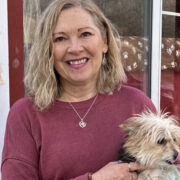News about programs at Mountain Projects
This story first appeared in The Mountaineer
For more than a decade in her previous hometown, Kim Hammon, now of Jonathan Creek, operated a non-profit called “Street Angels” that helped seniors, veterans and single mothers who were in dire straits. Her organization assisted thousands of people through the unexpected emergencies of life.
Recently, Hammon found herself on the other side of the equation.
When her utility bill came in nearly double its previous high and she faced a potential cutoff, the retired teacher needed help.
“Social security isn’t a whole lot,” she says. “I have to budget my money.”
Like many, Hammon spends times of frigid weather in extra layers of clothing or at a relatives’ house. She keeps the heat warm enough to protect the pipes, and that’s about it. But also like others, she has seen her bill double – or more.
“When I got my utility bill I immediately thought ‘this isn’t mine’,” she said.
The North Carolina Utilities Commission approved a 7.7% rate increase that began last month, and increases will continue in 2025 and 2026 as energy providers work to transition to low-carbon energy sources. But Hammon’s electricity provider, Haywood EMC, told her that their rate hike was 18%. She was also told that payment options were limited.
“I said ‘are you kidding me?’” Hammon said. “I don’t know what will happen for people who live on less. It’s just shocking to be in this situation. They’ll shut you off, and I mean right now.”
Local social services agencies are stretched thin, and many people on fixed incomes, like Hammon, don’t fall into an income pool that would qualify them for help from the Department of Social Services. A recent study by the Federal Reserve entitled Economic Well-Being of U.S. Households found that more than one-fourth of American adults had one or more bills that they were unable to pay in full in a given month, or were one $400 financial setback away from being unable to pay them.
That’s where organizations like Mountain Projects come in. Mountain Projects operates a “Winter Warmth” discretionary fund, maintained through community donations.
Mountain Projects Executive Director Patsy Davis says Hammon is an example of the type of emergency her community action agency often helps.
“Some of us can deal with price spikes,” said Davis. “And there are some resources for people with very low income. But people with fixed incomes, particularly seniors and the disabled are stuck. When the tulips start blooming these people will still be struggling. The early spring is a time we see disconnects go up.”
___
Marla Wengyn is in the same boat as Hammonds. Wengyn, 58, lost her husband a few years back and lives with her special needs brother Charles “Big Mac” Hughes, 64.
Wengyn has a twenty-year-old massage therapy business, but can’t work the same hours as in the past because of her age.
Their house is small – 1,600 sq. ft. – and she keeps the thermostat low. They have few appliances. Still she says their power bills more than doubled this winter. Their bill for a relatively mild December exceeded $400, which left her puzzled.
“I try to use good judgment. Our thermostat stays at 64, and we wear thermal underwear,” Wengyn says. “No one is on oxygen. We cut back between 4pm and 8pm, when electricity is most expensive, but nothing seems to help. I open up the bill and it is very discouraging. It’s really frustrating.”
She reached out to the utility provider for an inspection, which was provided, but didn’t produce much she could change. She applied for a funded program through another organization to seal her crawl space, but her income exceeded their limit.
“I’m providing for us, but it’s getting scary,” she says.“ Is there a limit to what they can charge us? I can see that coming down the road. Do I eat or do I pay for my electricity? I feel for everyone in this situation.”
___
When Amy Roberts’ husband passed away, she moved from the Waynesville home they’d shared for 37 years to a 400 sq. ft. tiny home in Jonathan Creek. She’s a retiree on a fixed income, and her move was complicated by a bad fall in which she suffered a broken neck.
Her home is relatively new, and her habits are frugal, but recent power bills have tipped the scale for her.
“They told me my usage had gone up 171%,” Roberts says. “Realize now, I live in 400 square feet. I’m trying to cut back on my usage, and we’ve had a little better weather, but it’s really hard.”
Last year, Roberts says, her bills were in the $80 range, but a recent bill reached over $200.
When she called to ask about a payment plan, Haywood EMC representatives referred her to DSS, but, like others, her year-round income exceeded their limit.
___
There are common themes between the stories of Hammon, Wengyn and Roberts: they say local utility representatives are polite, but inflexible. And they say that drastic energy bill increases are the talk of the town. Also, Mountain Projects was able to help them all.
“I wouldn’t be in this house right now if it wasn’t for Mountain Projects,” Hammon says.
She remembers her work in the non-profit realm: “We helped to cover many expenses for people, and I understand the whole cycle of how this happens. The utilities and the groceries – it’s just startling and shocking to see that you can’t make ends meet. Mountain Projects was a Godsend for me and so are the donors who make emergency help possible. It’s just a miracle that people care. Tears were rolling down my face. I didn’t know what to do.”
But Davis says the organization’s pool of resources is limited. Most of its overall budget comes from grants, and those funds are restricted to specific programs.
“We can’t access restricted funds to support utility assistance or emergency funds requests,” Davis says. “That’s why we reach out to the community.”
Mountain Projects isn’t the only non-profit organization in Haywood County to help with these types of scenarios, but have received at least 100 calls for emergency assistance since the recent cold weather.
“Low to middle income people are often living paycheck-to-paycheck and they are one high utility bill away from choosing between food and medicine. Rent, food and utility bills are so high these days. We appreciate donations to help community members bridge these situations. You just can’t let people go without heat in the winter,” says Davis.
In order to make sure that our programming aligns with the needs of our community, we request your assistance in filling out the accompanied survey. The survey is designed to provide us with accurate information about housing conditions in our community and the housing situations of our residents. Survey information will be used to:
- Help Mountain Projects staff develop a housing plan
- Identify housing projects that will meet the needs of our community
- Provide information to pursue funds for housing projects through state, federal, and private sources
Please complete the survey by 12/31/2023. The information you provide will be kept confidential and anonymous.
Your cooperation and assistance is greatly appreciated! Remember, this survey is important in identifying housing projects and funding for which Mountain Project’s clients may qualify!
Community Survey: https://forms.office.com/r/AJsXZ1bwmT
Employer Survey: https://forms.office.com/r/ACVKpAQDpp
Real Estate Survey: https://forms.office.com/r/D3cr4J0XwN
Written by Judy Dykes & Katie Ray
Every week, we volunteer at the Mountain Projects Resale Store. For several hours, we sort through, quite literally, mountains of donated clothes and household goods. We separate the gently-used and ready-to-sell from the served-its-time and must-be-recycled, and off and on, all morning, we open up bags and we find treasure. Three pairs of Talbots corduroy jeans in different fall colors. A beautiful hand-crafted pottery bowl. The cutest little black cocktail halter dress (if only we were 30 years younger). The perfect pair of trekking poles for hiking. And every time we find one of these treasures, we can’t wait to put it out on the floor where some lucky person who needs or wants just that can find it.
As anyone who shops in thrift stores knows, “thrifting” really is like going on a treasure hunt, but in addition to how much fun it is, there are other good reasons to shop in thrift stores.
First, thrifting is good for the environment. So many of us these days are trying to make greener, more sustainable choices. We carry our own bags to the grocery store, use cloth napkins instead of paper, and refill our water bottles when they’re empty. Whenever we can, we up-cycle, recycle, and re-use. And while many of us donate clothes and household goods we no longer want or need to local thrift stores, not nearly enough of us are shopping for things we need in those same stores. To be effective, the recycle equation needs people working both sides of it, contributing and consuming, because whatever doesn’t sell will eventually end up in a landfill.
Think of it this way. Thrifting is more about exploring possibilities than simply meeting needs, but once you’re committed to the principle of consumer recycling, shifting your shopping habits is not that hard to do. It may take a little patience and searching, but you don’t have to compromise excellent taste and quality to shop in a thrift store.
Finally, don’t forget that every time you purchase something in a thrift store, you support some local nonprofit organization that does a lot of good in our community and beyond. You can buy yourself a like-new LL Bean winter coat and make a donation at the same time—it’s a win-win situation!
So before you jump online to put in yet another order for something, why not jump in the car instead and head out to one of the many local thrift stores in Waynesville: Mountain Projects, Within Reach Resale Shop, Haywood Christian Ministry, Salvation Army, Goodwill, Second Seasons, Habitat for Humanity ReStore, to name just a few. In fact, grab a friend—or two or three—and make it date. Once a month, have lunch and visit as many of them as you can. After all, you never know what treasure might be waiting there for you!
Caption: Pictured here, Roxanne McCarthy, Katie Ray and Judy Dykes ALL wearing clothing and jewelry from the MP resale store.
PRESS RELEASE – July 21, 2023 / Media Contact: Patsy Davis, [email protected] or 828-492-4124
GetCovered WNC/Milltown Health Care Initiative – providing relief for premium costs and expert help on getting health insurance
Canton, N.C. – A program to assist those who have lost health insurance due to the closure of Pactiv Evergreen is well underway thanks to a joint effort between Mountain Projects, United Way of Haywood County, and Haywood County government.
Through funding support from Dogwood Health Trust, former mill workers, or those downsized in other businesses because of the Pactiv Evergreen closure, can receive assistance from Mountain Projects’ certified application counselors to help find healthcare coverage that’s right for them and their family members. Workers may also receive up to $500 per family member per month as reimbursement for health insurance premiums.
Jan Plummer from Mountain Projects has been leading the effort to let mill employees know of health insurance options. “We are seeing more and more folks coming through, now that the reality of the mill closure is setting in,” she said. “We are here to listen, answer questions, provide information, and walk everyone through health insurance options that are available to them. Having funding to assist with costly premiums is a huge relief to many who are facing the sticker shock of coverage costs.”
Certified Application Counselors at Mountain Projects are experienced in wading through the complexities of insurance options. United Way of Haywood County will disburse funds to assist with premium cost reimbursement. The reimbursements are non-taxable and are available to displaced workers for coverage costs that occur July 2023 through December 2023.
“We’re very pleased to have this program up and running quickly. There is an urgency to the help we want to provide because employer-sponsored insurance for most Pactiv Evergreen workers runs out at the end of July. We encourage everyone to explore their options and don’t delay the decision to stay covered,” said Celesa Willett, executive director of United Way of Haywood County. “A lapse in coverage can be financially devastating and discourages folks from seeking the care they might need for themselves or their families.”
For more information about the GetCovered WNC/Milltown Health Care Initiative visit:
Get Covered WNC – GetCoveredWNC or Losing Your Health Insurance And Don’t Know What To Do? Get Help NOW! | Mill Town Strong
Appointments can be scheduled online at https://calendly.com/mpinc between 8am -5pm, Monday – Thursday; Or workers can call Mountain Projects – 828-452-1447 to schedule an appointment by phone.
Online applications are available at MountainProjects.org.
For other inquiries, contact Celesa Willett, United Way of Haywood County by email [email protected] or by phone, 828-356-2832.
FOR IMMEDIATE RELEASE: February 15, 2023
Mountain Projects
2177 Asheville Road
Waynesville, NC 28786
Press Contacts: Executive Director, Patsy Davis, [email protected], 828-452-1447
Program Manager, Jan Plummer, [email protected], 828-499-3222
Transitioning from Medicaid to Marketplace Coverage in 2023
The process of termination (unwinding) of Medicaid coverage for those enrolled in the program because of the Covid Public Health Emergency begins on April 1, 2023.
The Department of Health and Human Services began evaluating eligibility of enrolled recipients on February 1, reviewing household monthly income, age, employment status, and changes in family size. As a result, many people will discover they are no longer eligible for full Medicaid coverage. Consumers are therefore strongly encouraged to apply for coverage through the Health Insurance Marketplace, or Healthcare.gov, where insurance plans are available. Most people can qualify for a plan that costs less than $10 a month.
If you need help, Mountain Projects has expert insurance counselors on staff to help create an account, navigate the application, and determine eligibility for tax credits, all at no charge. This program is called GetCoveredWNC. Appointments can be made by calling (828) 452-1447.
The “unwinding” of Medicaid will not happen all at once. NCDHHS has 14 months to complete the recertification process. There are an estimated 300,000 North Carolinians who could lose their Medicaid between March 31, 2023 and July 31, 2024. DSS workers will be referring consumers to organizations like Mountain Projects to check their eligibility for Marketplace plans on healthcare.gov.
Persons losing Medicaid will begin receiving notices as early as February and should contact Mountain Projects’ GetCoveredWNC counselors to create an account on Healthcare.gov in advance of April 1st, 2023 to avoid a lapse in coverage when their Medicaid ends.
A person who loses Medicaid may be eligible for $0 monthly premiums on the Health Insurance Marketplace. (MP) The MP cannot turn someone away because of preexisting conditions; and plans cover the majority of services that Medicaid covers.
The Mountain Projects team of Certified Application Counselors is available to screen and enroll consumers in all seven counties of Western NC and the Qualla Boundary throughout the unwinding phase.
Special Enrollment Period (SEP)
People who lose Medicaid and Children’s Health Insurance Program (CHIP) coverage any time between March 31, 2023 and July 31, 2024 will be eligible for a Marketplace SEP. After a person is deemed eligible for the Marketplace subsidies, they will have 60 days to choose a plan, and their coverage will start the first day of the month after they choose a plan.
This opportunity allows people who lose Medicaid or CHIP to get enrolled anytime between March 31, 2023 and July 31, 2024, no matter when their Medicaid ended.
The SEP is triggered when someone answers “yes” to the application questions asking if their Medicaid/CHIP coverage ended recently or will end soon. People will not be required to supply documentation to verify their loss of Medicaid/CHIP.
Contact Certified Application Counselors by County:
In Haywood County: Jane Harrison, Vicky Gribble and Jan Plummer, Coordinator: 828 452-1447 at Mountain Projects, Inc. 2177 Asheville Road Waynesville, NC 28786
In Jackson County: Marilyn Tollie (bilingual assistance in all counties) 828 550-3686; and Susan Rose: 828 476-9194 located at 154-B Medical Park Loop, Sylva, NC 28779
In Swain and Graham Counties: Linda Fitzsimmons: 828 550-7908
In Macon County: Cynthia Solesbee: 828-400-4177
In Clay and Cherokee Counties: Linda Curtis-Palmieri: 828 400-3149
Appointments are available in-person, by phone, or by video call.
GetCovered WNC, a program of Mountain Projects is supported by the Haywood Healthcare Foundation for Haywood County, The Dogwood Health Trust and The Kate B Reynolds Charitable Trust.
###
New policies deliver lower prices for healthcare

The recently enacted Inflation Reduction Act is good news for senior citizens on Medicare and for consumers enrolled in Affordable Care Act health insurance through the Marketplace.
For people who have their health insurance through the Affordable Care Act Marketplace, the lower premium rates that were implemented during the COVID emergency will continue through 2025. The new 100% – 150% Special Enrollment Period will also continue. If you have never checked out your out of pocket costs for good health insurance through the Marketplace, now would be a good time to do so. If you still need coverage for 2022, you may qualify for a Special Enrollment Period that could get you coverage.
Beginning with the 2023 coverage year, seniors on Medicare can get vaccines with NO out of pocket costs to them. Also the price of insulin is capped at $35/month beginning in 2023. Medicare beneficiaries with Medicare Part D will have their out of pocket costs for their prescription drugs capped at $4000 or less per year in 2024 and at $2000 in 2025. Knowing what the yearly maximum cost of your drugs will be extremely helpful for seniors on tight budgets.
Everyone who has Marketplace coverage, now and will need coverage in 2023, needs to renew their coverage during the upcoming Open Enrollment. Open Enrollment for the 2023 coverage year will start November 1, 2022 and be open through January 15, 2023.
There are free, experienced and certified, in-person coverage counselors available to help you understand the numerous health plans that are available. Coverage counselors can assist you with the application process.
Call 828-452-1447 for the name and number of a coverage counselor in your community. More information can be found at www.GetCoveredWNC.org.
101 Back-to-School Tips for Kids and Parents
As summer comes to an end and back-to-school season begins, it can be hard to get back into a regular schedule – both for kids and adults.
The trick here is to plan ahead. Read through this list and identify some strategies that you think could help you and your family stay organized and on top of things. Then, test these different approaches as a family so you can figure out which ones work for you, and which ones don’t.
Finally, make sure that you include your entire child care crew in your plans, too. No matter whether you have a babysitter, a nanny, a tutor, or all of the above, they’ll be able to help you keep your kiddo on track for the first day of school. Plus, they’ll be able to take some tasks off of your plate – which means that you can enter the school year with a little more of your sanity intact.
- Set your kids’ sleep schedules back to “School Time” two weeks before the first day.
- Get your kids involved in programs that they can do after school to keep them active.
- Visit cultural attractions like museums to shift their brains into “Scholar” mode.
- Hire an after-school sitter to help care for your kids while you’re at work.
- Encourage your kids to read at least one book before the school year begins.
- Reacquaint your kids with the calendar schedule they’ll use to manage their activities.
- Try apps like iHomework or MyHomeWork to help your kids organize assignments.
- Let kids choose a planner or scheduling tool that they’re excited to use.
- Set up weekly meetings to review your kids’ schedules for the week(s) ahead.
- Create a family calendar that tracks everyone’s activities and commitments.
- Refresh your rules about screen time for the school What’s allowed and when?
- Establish a set “Family Time,” whether it’s during dinner or before bed.
- Give kids a specific day to when they can choose all the activities you do together.
- Determine how long it takes them to do assignments to help with time management.
- Use an egg timer to get your kids used to focusing for specific periods of time.
- Teach your kids to prioritize their assignments by making to-do lists with deadlines.
- Give your kids a short break after each assignment they finish, such as a short walk.
- Set a regular alarm each day that signals the start of homework time.
- Discuss what your kids can expect on the first day so they feel more prepared.
- Visit the school with your kids so they can get familiar with their new environments.
- Arrange playdates with two or three of your kids’ friends to rebuild existing social ties.
- Ask teachers for class rosters so you can arrange playdates with new classmates too.
- Get the lists of school supplies, books and technology your kids will need.
- Inventory last year’s school supplies before going out to buy more.
- Include your kids in back-to-school shopping by letting them pick out their items.
- Make a plan for organizing those supplies – and keeping them that way.
- Create a dedicated space for your kids to store their school supplies and technology.
- Establish a specific space like the family office as the official “homework area.”
- Remove distractions like TVs and video game consoles from homework areas.
- Repurpose and relabel plastic tubs to organize all school supplies.
- Help your kids develop a filing system for organizing their documents for each class.
- Set – and enforce – regular weekday and weekend bedtimes.
- Set – and enforce – regular weekday and weekend wake-up calls.
- Keep track of existing extracurricular activities to prevent over-scheduling.
- Have your kids set realistic goals for the new year, such as reading 30 books.
- Help your kids prioritize their activities by tying them to their year’s goals.
- Create a list of fun after-school activities and games to keep your kids entertained.
- Touch base with teachers early on to troubleshoot any issues your kids may be having. Here are 20 questions you can ask.
- Create an after-school schedule that allows time for snack, relaxation, play and study.
- Establish regular bedtime routines for elementary school kids and pre-schoolers.
- Carve out blocks of fun time for your kids, whether it’s through sports or playdates.
- Hire a tutor, babysitter or homework helper to help you navigate homework time.
- Model good behavior by doing your own work/projects while your kids do homework.
- Encourage your kids to lay out their school clothes the night before.
- Use this printable checklist to establish a regular morning routine.
- Have your kids pack their school bags before they go to sleep that night.
- Have your kids also pack their gym bags the night before and leave them by the door.
- If your kids bring their own lunch, pack their lunch boxes before going to bed.
- Establish rules for where they should put lunchboxes, when they come home.
- Revamp your home organization setup to be more kid-friendly. For example, low hooks make it easy for younger children to hang up coats!
- Go through your kids’ schoolwork once a month to toss the things you don’t want.
- File or scan assignments that you want to keep.
- Create an inbox for kids to leave things that need your attention, like permission slips.
- Designate a plastic tub as a put-away bin for anything that’s out of its place.
- Set a time each week to sync up individual calendars with the family calendar.
- Inventory your kids’ wardrobes and toss/donate things they’ve outgrown.
- Create a list and budget for back-to-school shopping.
- Let your child choose their clothes, shoes and other items they’ll need.
- Go through their wardrobes every 2-3 months to get rid of things that no longer 60.Set up a laundry system that makes it easy to sort and wash everyone’s clothes.
- Make homework caddies that can be used to carry school supplies through the house.
- Buy bulk packaged snacks like bags of grapes that can be easily added to lunches.
- Discuss the different pros and cons of bringing versus buying school lunches.
- Get copies of school menus in advance to discuss lunch choices.
- Get your kids involved in creating and preparing their daily lunch menus.
- Buy reusable sports bottles to increase their water consumption during the day.
- Keep a small emergency allowance in your kids’ bags, just in case.
- Organize lunch ingredients in one part of the fridge so you can make fast lunches.
- Purchase lunch boxes or reusable bags to help save the environment.
- Make a week’s worth of sandwiches on Sunday, wrap in tinfoil, and unthaw them the night before.
- Use sticky notes to flag important items in kids’ that they should pay attention to.
- Plan supervised study dates when kids work together on projects or homework.
- Have a backup transportation mode planned in case your kids miss the bus.
- Set your clocks forward 10 minutes. This makes it easier to be on time.
- Schedule blocks of time to check in with each child to see how things are going.
- Schedule at least one 30-minute block in your calendar each day for “you time. “
- Create a rewards system for when they meet goals like helping around the house.
- Shop for school supplies and clothes early. Avoid the rush.
- Use positive phrasing, such as “You can go outside after your homework is done,” rather than “You’re not going outside until this is finished.”
- Make sure your kids (and you!) have an effective wake-up alarm that works for them.
- Set an alarm or notification 30 minutes before bedtime.
- Remove things like mobile devices from kids’ bedrooms to focus them on sleeping.
- Use night lights, white sound machines and fans for kids who can’t get to sleep.
- Keep a single, easy-access file for vaccination records and other important papers.
- Set up the breakfast table before you go to bed.
- Map out a bathroom schedule to avoid family fights for bathroom time.
- Replace old backpacks with ones that are sturdy, ergonomic and kid-friendly.
- Keep a running list of supplies, clothing and food that need to be bought each week.
- Use a see-and-store toy rack to make it easier for kids to stay organized.
- Set up a hanging organizer with five boxes for clothes for each day of the week.
- Dedicate a rack in the garage, basement or entry way for sports equipment.
- Create a regular pet care schedule that outlines who does what and when.
- Schedule study blocks on the weekends before big tests, mid-terms and finals.
- Use under-the-bed storage for off-season clothes and toys that aren’t regularly used.
- Give everyone a shower caddy to keep bathroom supplies organized.
- Have a playdate caddy ready to go, with an extra set of clothes, games and toys.
- Figure out different ways you can be involved in the classroom this school year.
- Talk openly with your kids about their feelings about returning to school.
- Do something fun to diffuse this stressful time of year for all of you!
- Take a breath!
With all this preparation, your kids will be in great shape. If you’re relaxed and calm, they’ll head off to school feeling excited and ready to get to work.
Resources: www.ces-schools.net
Provided by: www.eannc.com











